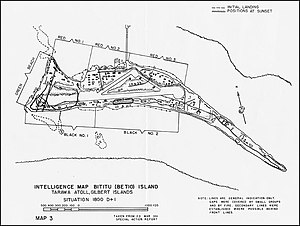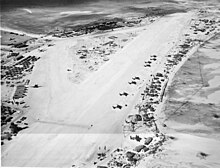
The Battle of Kwajalein was fought as part of the Pacific campaign of World War II. It took place from 31 January – 3 February 1944, on Kwajalein Atoll in the Marshall Islands. Employing the hard-learned lessons of the Battle of Tarawa, the United States launched a successful twin assault on the main islands of Kwajalein in the south and Roi-Namur in the north. The Japanese defenders put up stiff resistance, although outnumbered and under-prepared. The determined defense of Roi-Namur left only 51 survivors of an original garrison of 3,500.
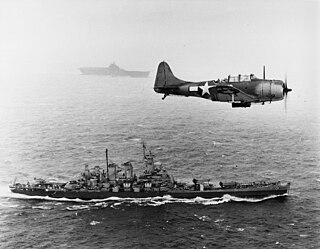
The Gilbert and Marshall Islands campaign were a series of battles fought from August 1942 through February 1944, in the Pacific theatre of World War II between the United States and Japan. They were the first steps of the drive across the central Pacific by the United States Pacific Fleet and Marine Corps. The purpose was to establish airfields and naval bases that would allow air and naval support for upcoming operations across the Central Pacific. Operation Galvanic and Operation Kourbash were the code names for the Gilberts campaign that included the seizures of Tarawa and Makin, during the Battle of Tarawa of 20–23 November and the Battle of Makin of 20–24 November 1943. Operation Flintlock and Operation Catchpole were aimed at capturing Japanese bases at Kwajalein, Eniwetok, and Majuro in the Marshall Islands.

Bonriki International Airport is an international airport in Kiribati, serving as the main gateway to the country. It is located in its capital, South Tarawa, which is a group of islets in the atoll of Tarawa in the Gilbert Islands, precisely on Bonriki.

Funafuti International Airport is an airport in Funafuti, in the capital city of the island nation of Tuvalu. It is the sole international airport in Tuvalu. Fiji Airways operates between Suva and Funafuti. Air Kiribati provides one flight a week from Tarawa to Funafuti.

Bucholz Army Airfield is a United States Army airfield located on Kwajalein Atoll, Marshall Islands. Its position is ideal for refueling during trans-Pacific flights, and the airport is available to civilians through Air Marshall Islands and United Airlines.

Santo International Airport is an airport in Luganville on Espiritu Santo in Vanuatu. The airport used to be called Santo-Pekoa International airport until it was renamed in the Vanuatu AIPV amendment released on 16 June 2021. Airports Vanuatu Limited provides aviation services for the airport.
Abemama Airport is the airport serving Abemama, Kiribati. It is located on the north of the atoll, 200 meters northeast of the village of Tabiang.
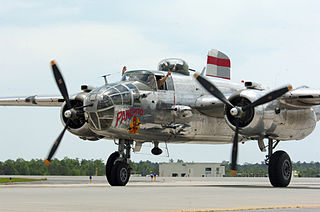
The 41st Tactical Group is an inactive United States Air Force unit. Its last assignment was with the 7217th Air Division at Cigli Air Base, Turkey, where it was inactivated in 1970. From 1966 to 1970 the group controlled deployed fighter squadrons.

The VII Bomber Command is an inactive United States Air Force unit. Its last assignment was with Seventh Air Force, based on Okinawa. It was inactivated on 31 March 1946.

South Field was a World War II airfield on Iwo Jima in the Volcano Islands, located in the Central Pacific. The Volcano Islands are part of Japan. The airfield was located on the southern corner of Iwo Jima located on the Motoyama plateau, to the north of Mount Suribachi. South Field was significant to the overall Battle of Iwo Jima.

East Field is a former World War II airfield on Saipan in the Mariana Islands, part of Naval Advance Base Saipan.
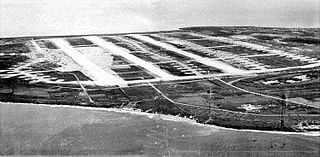
North Field is a former World War II airfield on Tinian in the Mariana Islands. Abandoned after the war, today North Field is a tourist attraction. Along with several adjacent beaches on which Allied forces landed during the Battle of Tinian, the airfield is the major component of the National Historic Landmark District Tinian Landing Beaches, Ushi Point Field, Tinian Island.

The 820th Bombardment Squadron is a former Army Air Forces unit, inactivated on 4 January 1946. The squadron was first activated during World War II as the 521st Bombardment Squadron. The squadron was soon engaged in the antisubmarine campaign off the Atlantic coast of the United States as the 16th Antisubmarine Squadron.
Alexai Point Army Airfield is an abandoned World War II airfield with two runways laid across Alexai Point on Attu Island, Alaska. The remains of the Seabee built airbase are located about 4 miles east of the closed Casco Cove Coast Guard Station, directly across Massacre Bay.

Majuro Airfield or Naval Air Facility Majuro is a former World War II airfield on the island of Delap in the Marshall Islands. The facility was supported by the large base, Naval Base Majuro

Nanumea Airfield is a former World War II airfield on the island of Nanumea in the Ellice Islands.

Naval Base Funafuti was a naval base built by the United States Navy in 1942 to support the World War II effort. The base was located on the Island of Funafuti of the Ellice Islands in the Western Pacific Ocean. The island is now Tuvalu, an island country in the Polynesian. After the surprise attack on Naval Station Pearl Harbor on December 7, 1941, the US Navy was in need of setting up more advance bases in the Pacific Ocean. At Naval Base Funafuti the Navy built a sea port, a small hospital, PT boat base, a seaplane base and an airbase.

Naval Base Tarawa was a naval base built by the United States Navy in 1943 to support the World War II effort. The base was located on Tarawa atoll in the Gilbert Islands in the Central Pacific Ocean. The base was built as one of many advance bases in the island-hopping campaign towards the Empire of Japan. At Naval Base Tarawa the Navy built a seaport, seaplane base and two airbases. Construction started after the Battle of Tarawa ended November 23, 1943, part of Operation Galvanic.

Naval Base Abemama was a naval base built by the United States Navy in 1943 to support the World War II effort. The base was located on Abemama atoll, also called Hopper Atoll, in the Gilbert Islands in the Central Pacific Ocean. The base was built as one of many advance bases in the island-hopping campaign towards the Empire of Japan. At Naval Base Abemama the Navy built a seaport and airbase. Construction started after the Battle of Abemama ended November 24, 1943, part of Operation Galvanic.

Naval Base Gilbert Islands were naval bases built by the United States Navy in 1943 to support the World War II effort. The bases were located on in the Gilbert Islands in the Central Pacific Ocean. The bases were built as part of the many advance bases in the island-hopping campaign towards the Empire of Japan. The largest base was the Naval Base Tarawa. At Tarawa the Navy built a seaport, supply depots, a small ship repair depot, Carrier Aircraft Service Unit, seaplane base and two airbases. Construction started after the Battle of Tarawa ended on November 23, 1943, part of Operation Galvanic. The bases were built by the US Navy's Seabees, Naval Construction Battalions. After the war the bases were abandoned. Some of the airfields became civilian airports.

